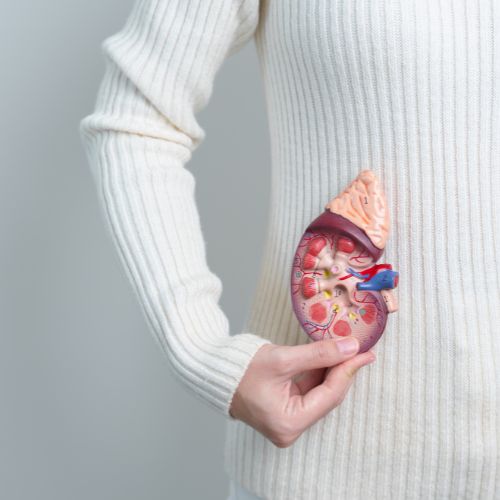Dr Anup Ramani @ Copyright 2024
By Dr. Anup Ramani
Kidney cancer, while relatively common, is often referred to as a “silent” disease because it can progress without noticeable symptoms in its early stages. By the time the symptoms appear, the cancer may have reached an advanced stage. Early detection plays a crucial role in improving the chances of effective treatment and survival. This article explores the early symptoms of kidney cancer that should not be ignored, helping individuals recognize potential signs early and seek medical intervention promptly. We will also discuss treatment options such as Robotic Surgery for Kidney Cancer, a modern technique offering minimal invasive surgery benefits and explore the significance of early detection in the context of Kidney Cancer treatment in India, especially in major medical hubs like Mumbai.
Silent Signals of Kidney Cancer: Early Symptoms You Shouldn’t Ignore
Kidney cancer may not present itself immediately and the early signs can often be vague or confused with other less serious conditions. However, recognizing certain signals early on can make a substantial difference in diagnosis and treatment outcomes.
Blood in the Urine (Hematuria)
The presence of blood in the urine is one of the most common and noticeable symptoms of kidney cancer. Blood may appear as visible red or pink discoloration or it may be detected only through laboratory tests (microscopic hematuria). This symptom is particularly alarming because it can be easily dismissed or misattributed to other causes like urinary tract infections or kidney stones. However, blood in the urine can be an early warning sign of kidney cancer, especially if it occurs intermittently. It’s important to seek medical attention if you notice blood in your urine, as this can help identify kidney cancer at an earlier, more treatable stage.
Flank Pain or Back Pain

Pain in the flank, which is the area along the side of the body or persistent pain in the lower back, may signal kidney problems, including kidney cancer. Kidney tumors can cause discomfort or pain as they grow, pressing against surrounding tissues. Often, the pain associated with kidney cancer is dull or persistent, but it may also be sharp. While back pain can be linked to a variety of other conditions like muscle strain, it is important to consider kidney cancer when it is unexplained or worsens over time.
Fatigue and General Dizziness
Fatigue is a symptom that is frequently observed in various types of cancer, including kidney cancer. As the body fights against the tumor, energy levels may be depleted, leading to a constant feeling of tiredness or malaise. If you find that your usual energy levels are lower than normal and there is no apparent reason, such as a lack of sleep or stress, it is important to monitor this symptom, especially if it persists. Additionally, unexplained weight loss and loss of appetite can also accompany fatigue, pointing to the possibility of an underlying health condition like kidney cancer.
Unexplained Weight Loss
Unintentional weight loss is another common symptom seen in many cancers, including kidney cancer. If you are losing weight without changing your diet or exercise habits, it may be a sign that something is wrong. Weight loss in kidney cancer often occurs due to the body’s increased energy use in fighting the disease. As the tumor grows, it may affect the body’s ability to absorb nutrients properly, contributing to weight loss. This symptom, when combined with others such as fatigue, pain or blood in the urine, warrants further investigation.

High Blood Pressure (Hypertension)
Kidney cancer can sometimes affect the regulation of blood pressure. The kidneys play an important role in controlling blood pressure by regulating the balance of salt and fluid in the body. When a tumor forms in the kidney, it can interfere with these functions, leading to high blood pressure. In some cases, this may be one of the first indicators of kidney cancer, especially in people who previously did not have hypertension. If you are experiencing high blood pressure that is difficult to control or newly diagnosed, it may be worth investigating kidney function further.
Swelling in the Legs or Ankles
Swelling in the legs or ankles can result from kidney cancer because tumors may block the kidneys’ ability to remove excess fluid from the body. This condition, known as edema, may cause fluid retention, leading to noticeable swelling in the lower extremities. Swelling can also occur in the abdomen if a tumor obstructs the blood vessels or lymphatic drainage. Any unexplained swelling in the legs, ankles or abdomen, especially when combined with other symptoms like fatigue or pain, should prompt a visit to a healthcare professional.
Early Detection and Diagnosis: The Role of Robotic Surgery for Kidney Cancer
Kidney cancer is often detected through imaging tests, such as ultrasounds, CT scans or MRIs, which can identify tumors within the kidneys. Once a diagnosis is made, the next step is determining the best treatment option. In recent years, Robotic Surgery for Kidney Cancer has become an increasingly popular approach due to its minimal invasiveness and precision. This technique, part of Minimal Invasive Surgery for Kidney Cancer, involves using robotic instruments to perform the surgery with smaller incisions, leading to less pain, quicker recovery and a reduced risk of complications compared to traditional open surgery.
For patients seeking Kidney Cancer Surgery in India, especially in prominent medical hubs like Mumbai, the availability of robotic surgery offers an advanced option for treating kidney cancer while minimizing trauma to the surrounding tissues. Dr. Anup Ramani, Kidney Cancer Surgeon specializing in robotic surgery can provide the expertise needed to perform these delicate operations, ensuring optimal outcomes for patients.
What Our Patients Are Saying
Kidney Cancer Treatment Options in India: Why Early Symptoms Matter?
The early symptoms of kidney cancer are critical in determining the type of Kidney Cancer treatment a patient will undergo. In India, hospitals and treatment centers offering Kidney Cancer Surgery are equipped with the latest diagnostic tools and advanced surgical options. It is particularly known for its excellence, with many hospitals providing cutting-edge treatment such as robotic surgery, chemotherapy, targeted therapy and immunotherapy.
Early diagnosis is key to ensuring that kidney cancer does not spread to other parts of the body. The sooner it is detected, the more treatment options are available and the higher the chances of a favorable outcome. Robotic surgery plays an integral role in offering patients a treatment with minimal discomfort and a faster recovery period, which is essential for maintaining quality of life during and after treatment.
Conclusion
Recognizing the early symptoms of kidney cancer is crucial to improving the chances of successful treatment and long-term survival. Symptoms such as blood in the urine, persistent pain, fatigue and unexplained weight loss may be subtle but can signal the presence of a more serious condition like kidney cancer. If any of these symptoms appear, it is important to consult a healthcare provider promptly.
Early detection allows for a wider range of treatment options, which offers patients the benefit of precision and faster recovery. It is essential for patients to seek professional guidance as soon as they notice any potential signs of kidney cancer, as this can make a significant difference in the effectiveness of treatment.
FAQs
What are the early signs of kidney cancer?
The early signs of kidney cancer include blood in the urine, persistent pain in the lower back or flank, unexplained weight loss, fatigue, high blood pressure and swelling in the legs or ankles.
What should I do if I notice early symptoms of kidney cancer?
If you notice any early symptoms of kidney cancer, it is crucial to consult with a healthcare provider as soon as possible. Early diagnosis can help in deciding the best course of treatment, which may include Robotic Surgery for Kidney Cancer or other advanced treatment options.
How is kidney cancer diagnosed?
Kidney cancer is typically diagnosed through imaging tests like CT scans, MRIs and ultrasounds. A biopsy may also be performed to confirm the diagnosis. A Kidney Cancer Surgeon will assess the results to determine the best treatment plan.
What is the role of robotic surgery in treating kidney cancer?
Robotic Surgery for Kidney Cancer is a minimal invasive technique that allows for more precise tumor removal with smaller incisions. This leads to less pain, quicker recovery times and fewer complications compared to traditional surgery.
Where can I find the best kidney cancer treatment in India?
India offers world-class kidney cancer treatment, particularly in cities like Mumbai, where hospitals are equipped with advanced surgical techniques, including robotic surgery. Consult a qualified Kidney Cancer Surgeon to explore the best treatment options available.
About Author

Uro-Oncological & Robotic Surgeon
Dr. Anup Ramani is a robotic uro-oncological surgeon and an internationally recognized expert in robotic surgery for prostate, kidney and urinary bladder cancers. With more than two decades of robotic experience and 2,000+ robotic procedures, he brings unmatched precision and outcomes to complex uro-oncology cases. He is widely published in his field and is known for a personal, transparent approach-often spending over an hour in initial consultations to educate patients on its disease, surgery and recovery. His expertise spans prostate cancer treatment, kidney and bladder cancer surgery, adrenal gland surgery, kidney stone treatment, penile cancer surgery and enlarged prostate management. Dr. Ramani advocates the advantages of robotic surgery-magnified 3D vision, tremor-filtered precision, minimal scarring, lower blood loss and faster recovery-helping patients return to life sooner.
Best Uro-Oncological surgeon
Specialist in India for Robotic Surgery
MCh, DNB, MS, DNB
Dr. Anup Ramani
CONTACT
Uro-Oncologist in India,
Best Robotic Surgeon for Uro Oncology Surgery
1407, One Lodha Place Next to World Towers Senapati Bapat Marg, Worli, Mumbai. 400013.
Dr Anup Ramani @ Copyright 2024 – Website Maintenance, SEO & GEO by Opal Infotech
- Partial penectomy is done in cases where glans and distal penis is involved with carcinoma.
- Partial penectomy is a type of organ-preserving surgery. Preservation of sexual and micturational function depends on the surgical dissection and reconstruction of residual urethra.
- Patients who develop stones in the kidney or ureter, often experience severe pain.
- This condition usually needs a procedure to remove the kidney stones.
- This procedure is called ureteroscopy and is performed very commonly.
- It does not require any cuts and hence it is painless.
- The procedure is performed with an endoscope inserted through the penis under spinal anesthesia.
- The scope is inserted through the penis into the kidney and stones are dissolved with a laser.
- The procedure takes about 40-50 minutes.
- A catheter (urine pipe) is kept after the procedure to drain the bladder. A stent is kept in the kidney at the same time.
- Patient is mobile and walking in the room the same evening.
- Hospital stay is one night and patient is discharged the next day after removal of the catheter.
- Patient has to come back after six weeks to remove the stent in the kidney.
- Patients can resume office a week after surgery and heavy activities like running, weight lifting, a month after the procedure.
- We offer fixed packages for this procedure which can be obtained by calling our helpline +91 9967666060.
- Men with an enlarged prostate, which is a normal ageing changes, often experiencing difficulty passing urine. This condition usually needs a procedure to trim the prostate and relieve the blockage.
- This procedure is called TURP and is performed very commonly.
- It does not require any cuts and hence it is painless.
- The procedure is performed with an endoscope inserted through the penis under spinal anaesthesia.
- The overgrown prostate is dissolved with a laser bloodlessly.
- The procedure takes about 40 minutes.
- A catheter (urine pipe) is kept after the procedure to drain the bladder.
- Patient is mobile and walking in the room the same evening.
- Hospital stay is two nights and patient is discharged with the catheter, which is removed after 4 days.
- Patients can resume office a week after surgery and heavy activities like running, weight lifting, a month after the procedure.
- We offer fixed packages for this procedure which can be obtained by calling our helpline +91 9967666060.
-
Robotic adrenalectomy is a sophisticated, complex surgery and it is very important that an experienced surgeon performs this surgery to avoid major complications.
-
Once the anesthesia is done, and patient positioned, three micro cuts (3mm each) are made in the patient’s abdomen.
-
The arms of the Da Vinci robot are connected to the cuts via ports (tubes).
-
Dr. Ramani then sits in the controlling console to perform the surgery.
-
On an average, a robotic adrenalectomy takes one hour.
-
The surgery is almost completely bloodless and there has never been any need to transfuse blood after surgery.
-
A urine catheter and bag to drain the bladder is inserted during surgery.
-
A tiny drain pipe may be inserted in the surgical side of the abdomen, connected to a bag.
-
Patient is kept nil-by-mouth the day of the surgery, with IV fluids. Sips of water are started the next day and solid food by day three.
-
The drain pipe, if kept, is removed in the room on day 2 after surgery.
-
The catheter is removed on day two after surgery.
-
Total hospital stay for robotic adrenalectomy is 4 nights (including night before surgery).
-
Post discharge, a doctor from the surgical team visits the patient at home/ hotel room once every day.
On the day of discharge, patient is totally self-sufficient. They are able to walk freely without any pain, dress themselves, shower, toilet and they do not need to hire any nurse or help at home. Almost all patients are back to work within 2 weeks of surgery.
Heavy activities like running, weight lifting can be resumed after a month
Follow up after an adrenalectomy is in the form of CT scans, once a year for 5 years.
Local patients usually meet Dr. Ramani after two weeks to discuss report.Outstation patients are counselled on a phone consultation.
- Dr. Ramani is one of the very few surgeons in India who has the expertise to perform a robotic surgery for bladder cancer, which includes removing the urinary bladder and reconstructing a new bladder robotically.
- Robotic radical cystectomy is an extremely sophisticated, complex surgery and it is very important that an experienced surgeon performs this surgery to avoid major complications.
- Once the anaesthesia is done, and patient positioned, six micro cuts (3mm each) are made in the patient’s abdomen.
- The arms of the Da Vinci robot are connected to the cuts via ports (tubes).
- Dr. Ramani then sits in the controlling console to perform the surgery.
- On an average, a robotic radical cystectomy with an ileal conduit takes 3-4 hours.
- The surgery is almost completely bloodless and there has never been any need to transfuse blood after surgery.
- A urine catheter and bag to drain the new bladder is inserted during surgery.
- Two tiny drain pipe in inserted in the surgical side of the abdomen, connected to a bag.
- Patient is kept nil-by-mouth for 4 days after surgery with IV supplementation of patient’s daily requirements of calories, fats, carbohydrates, proteins and electrolytes.
- The drain pipes are removed in the room on day 3-5 after surgery.
- Total hospital stay for radical cystectomy is 8 nights (including night before surgery).
- Post discharge, a doctor from the surgical team visits the patient at home/ hotel room once every day.
- On the day of discharge, patient is totally self-sufficient. They are able to walk freely without any pain, dress themselves, shower, toilet and they do not need to hire any nurse or help at home.
- Almost all patients are back to work within 6 weeks of surgery. Heavy activities like running, weight lifting can be resumed after two months.
Follow up after a radical a cystectomy is in the form of CT scans, once a year for 5 years.
Histopathology report: Local patients usually meet Dr. Ramani after two weeks to discuss report.
Outstation patients are counselled on a phone consult. Depending on the report, patient may or may not need chemotherapy after surgery.
If chemo is needed, patients may choose to get it done with a medical oncologist of their choice or avail the services of one of the four medical oncologists on our team.
- Robotic partial nephrectomy is a sophisticated, complex surgery and it is very important that an experienced surgeon performs this surgery to avoid major complications. Robotic radical (total) nephrectomy is
- relatively easier but still requires significant experience to consistently deliver results.
- Once the anaesthesia is done, and patient positioned, five micro cuts (3mm each) are made in the patient’s abdomen.
- The arms of the Da Vinci robot are connected to the cuts via ports (tubes).
- Dr. Ramani then sits in the controlling console to perform the surgery.
- On an average, a robotic radical nephrectomy takes one hour and a robotic partial nephrectomy takes about an hour and half.
- The surgery is almost completely bloodless and there has never been any need to transfuse blood after surgery.
- A urine catheter and bag to drain the bladder is inserted during surgery.
- A tiny drain pipe in inserted in the surgical side of the abdomen, connected to a bag.
- Patient is kept nil-by-mouth the day of the surgery, with IV fluids. Sips of water are started the next day and solid food by day three.
- The drain pipe is removed in the room on day 3 after surgery. The catheter is removed on day two after surgery.
- Total hospital stay for radical/partial nephrectomy is 4 nights (including night before surgery).
- Post discharge, a doctor from the surgical team visits the patient at home/ hotel room once every day.
- On the day of discharge, patient is totally self- sufficient.
- They are able to walk freely without any pain, dress themselves, shower, toilet and they do not need to hire any nurse or help at home.
- Almost all patients are back to work within 2-3 weeks of surgery.
- Heavy activities like running, weight lifting can be resumed after a month.
- Follow up after a radical/partial Nephrectomy is in the form of CT scans, once a year for 5 years.
- Local patients usually meet Dr. Ramani after two weeks to discuss report.
- Outstation patients are counselled on a phone consultation.





